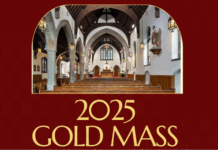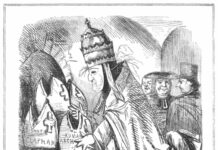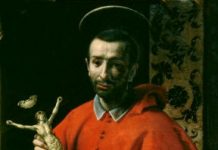On entering the house, they saw the Child with Mary his Mother; and they knelt down and paid Him homage. Then, opening their treasure chests, they offered Him gifts of gold, frankincense, and myrrh (Mt. 2:11-12). ⧾
Our celebration of the Solemnity of the Epiphany completes our commemoration of the Mystery of the Incarnation which Christmas celebrated. The radiance of Christ the Light of the world which today’s Feast of the Epiphany proclaims, is a Light that cannot be overcome by any power, earthly or spiritual. In him was life and the life was the light of men. The light shines in the darkness, and the darkness has not overcome it (Jn. 1:4-5). The Epiphany celebrates the manifestation of Christ Our Lord to the whole world. In keeping with an ancient tradition of the Church, you have just heard The Announcement of Easter and the Moveable Feasts. This proclamation expresses our desire and intention to permeate the whole year with the grace of the Mystery of Christ as we celebrate the great Feasts of our faith.
Wise men from the East came to Jerusalem, asking, ‘Where is the child who has been born king of the Jews? For we observed his star at its rising, and have come to pay him homage’ (Mt. 2:2). Who were these wise men, these magi? According to St. Jerome, they were sober students of the stars. They belonged to the great tradition of astronomy that had developed in Mesopotamia over the centuries and continued to flourish. Undoubtedly they had heard of the prophecy of the Gentile prophet Balaam: A star shall come forth out of Jacob and a scepter shall rise out of Israel (Num. 24:17).
On entering the house, they saw the child with Mary his mother; and they knelt down and paid him homage. Then opening their treasure chests, they offered him gifts of gold, frankincense, and myrrh (Mt. 2:11-12). The treasures of the Epiphany affirm by implication the true nature of the Incarnate Son: Gold as to a king, frankincense as a sacrifice to God, myrrh as embalming the body of the dead (St. Gregory the Great). The Holy Infant is the one eternal Son in two natures, the Divine Saviour, at once kingly and priestly, who comes to conquer Satan’s pride and atone for Adam’s sin. The three gifts offered to Him refute all the errors and heresies surrounding His true nature as God and Man. This is more than a child. He is the Word Incarnate. On entering the house, they saw the child with Mary his mother; and they knelt down and paid him homage. Their simple gesture is instructive for every succeeding generation in the Church, including ours; and perhaps especially for ours. The Magi provide us with a noble example of devotion to the Incarnate Son in His several dwelling places, that is, to Jesus in the womb and arms of Our Lady, Jesus in the Sacred Host, and Jesus in the hearts of His Saints. The kneeling down of the Magi is especially instructive and necessary. We, too, should kneel down when we enter the church, the House of God and find the Incarnate Son substantially present, yet humbly hidden, beneath the sacramental species in the Tabernacle. Of all the ways in which He is present on earth, this is the most excellent and the most deserving of our love and devotion.
You may remember that on Christmas Day the instruction or rubric in the Missal instructed us to kneel during the recitation of the Creed at the words and by the Holy Spirit was incarnate of the Virgin Mary and became man. Sadly, because in the Novus ordo Mass this is now done only twice a year, most people at Mass glossed over these words without pausing and did not observe the instruction or rubric. You may be asking why this is so important. Are we in danger of becoming like Pharisees obsessing over these ritual trivialities? The answer to this question is both yes and no; yes the Pharisees did not believe in the divinity of Our Lord, and no, this is not a trivial or unimportant ritual action. For centuries at Mass we always knelt at these words. It enabled us to adore and to ponder the Mystery of the Incarnation, the central Mystery of our faith. This ritual act and other expressions of adoration and humility before the Mystery of God are of great spiritual benefit; but like many ritual expressions of piety they were arbitrarily removed from our liturgy; and this has not served us well. It has made us proud and presumptuous; not servants of the Mysteries of God but their arbiters. I am speaking here principally though not exclusively of the clergy.
The sacred liturgy is everything. This is not an exaggeration. All the great works of art in every form, whether in architecture or music or even embroidery were inspired by the worship of God in the Mass which is always a celebration of the Redemptive Incarnation. It is worthy of note that great composers such as Bach, Mozart, Schubert, and Palestrina to name a few of the more notable ones in their musical settings provided even more elaborate melodies for these words (and by the Holy Spirit was incarnate of the Virgin Mary and became man) and those that immediately following the Creed: For our sake He was crucified under Pontius Pilate, He suffered death and was buried. These phrases express the Mystery of the Redemptive Incarnation, the very heart of the fullness of divine Revelation; our holy religion.
The Magi who knelt down and paid Our Lord homage teach us the lesson of humility before the Mysteries of God. More than any other virtue we ought to foster in ourselves an attitude of profound humility before Our Saviour. The Christ Child silently teaches us a lesson. If childhood can serve as an instrument united to His Divine person, it would seem to follow that there is some quality in childhood, even in us human persons that enables it to be in harmony with the God who became a Child. Hence in the midst of His public ministry He declared: Truly I say to you, unless you turn and become like little children, you will not enter the kingdom of Heaven (Mt. 18:3). May it never be said of us that we have become so sophisticated and proud, that we are blind and impervious to childhood’s dignity, and its awe and wonder especially in the presence of God both in His creation and in the sacred rites of the Church. The Christ Child Whom we contemplate invites us to conform ourselves to His life; so that our own lives may be a proclamation of our salvation in Christ as a light for the nations (Preface of the Epiphany).
We have celebrated the beautiful Feast of Our Saviour’s Birth and the sacred liturgy has enabled us to experience the awe and wonder of the Mystery of the Incarnation. Let us entrust ourselves to the loving protection of Our Lady and St Joseph, and learn from them to serve the Mystery of Christ at work in and through us. The Announcement of Easter and the Moveable Feasts clearly expresses our desire and intention to permeate the whole year with the grace of the Mystery of Christ. Let us resolve to prefer nothing to the worship of God so that like the Magi each week we will undertake a journey to this House of God, our own Bethlehem; and this journey, having become a familiar path will lead all of us ever more deeply into the Heart of Our Saviour. ⧾











